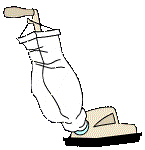The World Book Encyclopedia definition for goldfish is:
1. a small fish, usually of a reddish or golden color, golden carp. Goldfish are often kept in garden pools or in glass bowls indoors. They belong to the same family as the carp.
2. Slang. canned salmon.
![]() Back to top
Back to top
 Comments
Comments Goldfish are an inexpensive way to bring some “aqua - life” into your classroom! They certainly show appreciation when they are fed! They are very attractive and have some unusual characteristics, depending on the variety. The major problem with them is that “what goes in” also “comes out” in great abundance! You do have to expend some energy on cleaning out tank regularly!
![]() Back to top
Back to top
The traditional view of a goldfish is “in a bowl” on top of a bookcase or nightstand. Although a goldfish will live quite a while like this, it is definitely not the best housing! Animals do not like round containers, as a rule, in that there are no “safety corners” to retreat to. Also, if you are not adding extra aeration, there is a very small surface area for air exchange in a round bowl. The number of fish allowable is dependent upon their combined size. A rough formula is 2.5cm (1”) of fish per gallon of water (nb. don’t include the area taken up by gravel). A small 5 gallon tank would make a reasonable home for 8-10cm (3”-4”) of goldfish. If you have extra aeration, this 5 gallon tank could house 2 of the smaller variety of goldfish. Be sure you know how big your species could grow! Although you can change the water daily, it would be better to have a corner filter, or better yet, an outside filter. Goldfish like to grub in the gravel, which makes a real mess if you are using an undergravel filter. Filters help aerate the water as well as clean it. This necessitates the accompanying pump, tubing etc. to run the system. Use only a little (or no) gravel for the bottom of the tank. Plants are best made of plastic. Goldfish like to eat plants, so if you do purchase live plants, think of them as a food source rather than a permanent decoration. ( In one website I noted that crinium thianum was a plant that they did not eat and anubias and some crypts were also relatively successful plants for goldfish tanks.) Goldfish do not need a heater. Some sort of covering is advised. Goldfish don’t tend to jump out too often, but a cover stops other things from falling in! Also, don’t put your tank in a sunny window or near a heat register.
![]() Back to top
Back to top
Goldfish should be fed once a day. Goldfish flakes are available at pet stores, as are all sorts of fish ”treats”. Live brine shrimp is one of the best “treats” you could buy. Don’t overfeed your fish. Sprinkle a little food and then see if it is all gobbled up before adding any more. Uneaten food will spoil your water quickly and turn it cloudy. They can be left over a weekend, but it is best to add in a commercial “weekend fish feeder”.
![]() Back to top
Back to top
 Maintenance
MaintenanceThe water should be 1/3 changed weekly. The water should be at room temperature when added, so it is easiest to leave it out in a pail overnight. (Restrict this pail to “fish use only”!) Although this should safely remove any chlorine, the purchased additives which remove chlorine often have some extra water conditioners as well, so I recommend using them. Every so often you should have your water checked at the pet store (this is usually free-of-charge) just to check that your school water is meeting “fish standards”. If you do decide to purchase live plants, you will find that the goldfish like to probe about in the gravel, upsetting the roots and spreading out any soil... ie. extra maintenance required!
![]() Back to top
Back to top
Goldfish originated in China and Japan, and have been bred to obtain the interesting colors and shapes of today. Wild goldfish are drab in comparison to the interesting varieties available today. Some of the fancy varieties of goldfish , such as veiltails, were first bred in the sixteenth century by the Chinese. Goldfish were first bred in the U.S. in 1878 and now there are many goldfish farms in the U.S. There are several types of goldfish available. Some are only 5 to 8 cm (2” to 3”) whereas others grow to more than 30 cm (1ft.). Most goldfish in homes live less than five years, but some wild goldfish live about 15 years. Goldfish are related to carp. Golden carp may live to 50 years.
![]() Back to top
Back to top
 Characteristics
Characteristics• Goldfish are ectothermic (cold-blooded) and additionally, they are cold-water fish.
• Their skin is covered with scales.
• Goldfish breathe with gills - interesting to compare with lungs.
• They have a swim bladder to help adjust their body buoyancy in the water.
• They have two kinds of fins: single fins on the tail and back to provide stabilization and paired fins on either side which help steer and guide.
• Fish primarily move by rapid sideways movements of the body, not by fin movements!
• Fish have good senses of sight, smell, and touch. They “hear” with a set of nerves along their body (lateral line) instead of having external ears. They probably have a very poor sense of taste.
• There are some interesting varieties available. The comet is a popular, streamlined little fish, often sold as “feeder fish” for other animals. The lionhead has an amazing puffed up head and the popeye has exactly that... eyes that look popped out! The fantail and veiltail species have lovely long fins.
• They are notably greedy eaters and learn quickly about “feeding time”.
![]() Back to top
Back to top
• Study the basic anatomy of a goldfish. Look for the different fins, gills. Look for a lateral line.
• Watch how the goldfish breathes. Watch the pattern of movement in the mouth and the gills.
• Watch how the goldfish swims. Watch for patterns of movement in the fins.
• Move your finger along the outside of the glass. How does the goldfish react? Move your hand over the top of the tank. Does the goldfish follow your movements or shy away?
• Vary the living environment by adding different objects (be sure that they are safe for fish). See if the goldfish shows any interest in different sizes, shapes, colors of objects.
![]() Back to top
Back to top
Kramer, David C., Animals in the Classroom, U.S.A.: Addison-Wesley, 1989, pp.115-125
Pet Library, Learning About Goldfish, Ontario: Hartz Canada Inc.,
![]() Back to top
Back to top
Goldfish - A great site all about the care and needs of goldfish
http://www.geocities.com/Tokyo/4468/
Goldfish - Not so Common - an interesting article with a bit of goldfish history
http://users1.ee.net/tfrench/goldfish.htm
Goldfish FAQ - some interesting questions and answers
http://www.waltham.com/pets/fish/pfq01.htm
The New Tank Guide - how to set up your freshwater tank for the first time
http://www2.avicom.net/weif/firsttank.html
![]() Back to top
Back to top
| Getting around in this Web site |